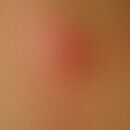Hierfür ist eine Anmeldung erforderlich. Bitte registrieren Sie sich bei uns oder melden Sie sich mit Ihren Zugangsdaten an.
DefinitionThis section has been translated automatically.
Occurrence/EpidemiologyThis section has been translated automatically.
Common in Africa. Occasionally brought to Europe by migrants.
You might also be interested in
ManifestationThis section has been translated automatically.
Occurs mainly among children, travellers or migrants.
ClinicThis section has been translated automatically.
Furunculoid granulomas around the larva stuck in the skin. After 2 weeks the larva hatches and pupates outside the human organism.
General therapyThis section has been translated automatically.
Removal of all fly larvae, first cleaning, then removal of crusts and pus remains, followed by occlusive dressing with an ointment (e.g. Vaselinum alb., paraffin, pig fat, beeswax) over a few hours. Due to O2 deficiency, the larvae move out of their crypts. Afterwards, they are cleaned again and fly larvae are removed by light pressure or with a needle or tweezers. In case of failure, icing of the affected area with chlorethyl spray and removal of the larvae with a scalpel. In the case of single small granulomas, removal can be done by punch biopsy.
External therapyThis section has been translated automatically.
After removal of all larvae, external antibiotic therapy with tetracycline-containing ointments (e.g. R250, Achromycin ointment), fusidic acid (e.g. fucidine ointment or cream), 2% clioquinol-containing topicals (e.g. R049, Linola-Sept).
Internal therapyThis section has been translated automatically.
In case of severe infestation systemic antibiotics such as erythromycin (e.g. Erythro-Hefa) 1.5-2 g, divided into 2-3(-4) ED, doxycycline (e.g. Doxy-Wolff) 2 times/day 100 mg p.o. or flucloxacillin (e.g. Staphylex Kps.) 3 times/day 1 g p.o. in 3 ED.
LiteratureThis section has been translated automatically.
- Frieling U et al (1999) Cutaneous myiasis--a vacation souvenir. dermatologist 50: 203-207
- Tamir J et al (2003) Myiasis with Lund's fly (Cordylobia rodhaini) in travelers. J Travel Med 10: 293-295
- Wilson ME et al (2004) Dermatologic Infectious Diseases in International Travelers. Curr Infect Dis Rep 6: 54-62
Incoming links (1)
Tumbu fly;Outgoing links (11)
Antibiotics; Clioquinol; Clioquinol cream 0.5-2% (o/w); Doxycycline; Erythromycin; Flucloxacillin; Fusidic acid; Granuloma; Myiasis (overview); Tetracycline; ... Show allDisclaimer
Please ask your physician for a reliable diagnosis. This website is only meant as a reference.




